Nutrition
The world of vitamins and minerals, and how they interact with the body is complex. We wrote this guide because of our interest in biology and nutrition, and to try and digest this information for ourselves. The guidelines listed below may change as research develops. If you are concerned about your intake of vitamins and minerals, we recommend seeing a dietitian who specializes in plant-based diets.
Remember, food ought to be regarded primarily as source of nourishment and pleasure, don't aim for perfection.

- Protein
- Iron
- Calcium
- Vitamin D
- Vitamin B12
- Iodine
- Omega-3's
- Vitamin A
- Zinc
- Meal plans
- Nutrition references

General rules:
- Eat at least 4 servings of vegetables per day.
- Eat at least 3 servings of legumes per day.
- Eat at least 4 servings of grains per day.
- Eat at least 3 servings of fruits per day.
- Eat at least 1 serving of seeds per day.
Protein

Proteins are necessary for the growth and repair of muscles, bones, hormones, digestive enzymes and to absorb nutrients. They're made up of 20 amino acids, 11 of which our bodies can synthesize. The other 9, the essential amino acids or EAA's, must come from the food that we eat.
The average protein intake that covers 97%–98% of the population ought to be 1.0–1.2 g/kg/day(requirements may vary depending on body type, and age).
Sources
Consume 3-4 servings of:
- 100g (1/2 cup) of cooked lentils
- 125-150 g of cooked beans (chickpeas, kidney beans, black beans etc.)
- 125 g of tofu or 165 g of tempeh
- 250 ml (1 cup) soy milk
- 185 g (1 cup) cooked quinoa
- 40 g (1/4 cup) of peanuts(or, 2 tbsp peanut butter)
Every plant protein contains all 9 of the EAA's, but in varying amounts. The body maintains reserves of amino acids for later use. The proteins of one meal can combine with proteins from another meal eaten later that day.
Legumes are the best source of lysine, one of the essential amino acids. Quinoa and amaranth are two grains that are rich in lysine, although not as much as legumes.
Read more(VeganHealth website) about proteins. Jump back to top.
Iron

Iron is necessary for red blood cells and to form hemoglobin, which help circulate oxygen around the body. We lose this mineral everyday from the skin and intestines, menstruating women will lose a lot more of it.
Sources
- Beans
- Soy (high in iron and not affected by phytic acid)
- Nuts
- Seeds
- Winter squashes
- Dark leafy greens
- Dried fruit
- Oatmeal
- Quinoa
- Pearled barley
- Whole grain bread
Iron-rich plant foods are high in phytic acid, a compound that binds to iron and other minerals and that is difficult for our bodies to absorb. Avoiding foods that contain phytic acid isn't necessary, but it's important to eat them in a way that minimizes their effects on iron.
Iron is plentiful in vegan diets. You can increase your absorption by adding vitamin C (increases it by 4-6 times) to your meals, avoiding tea (chamomille or pepppermint) or coffee at meals, eating more legumes, eating fermented grains (like yeast-leavened bread), cooking foods in a cast iron skillet (as the iron leeches into the food), and by avoiding calcium with meals.
Other iron inhibitors include: turmeric and coriander, or calcium rich foods.
Read more about iron. Jump back to top.
Calcium
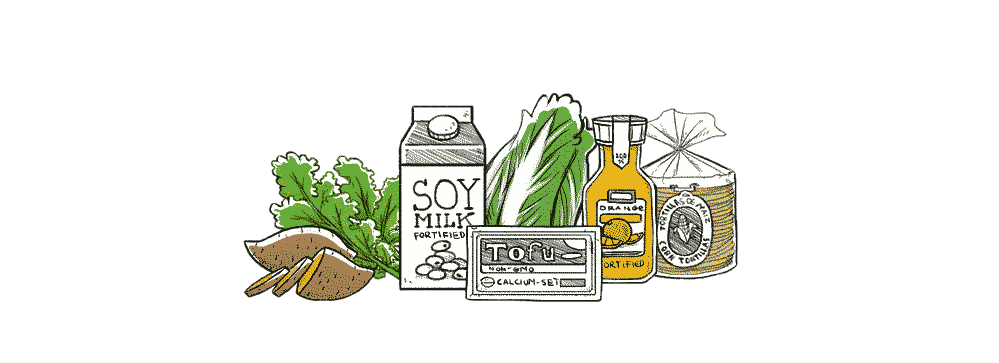
Sources
Consume at least 3 1/2 to 4 cups a day of:
- Calcium-set tofu
- Cooked Chinese cabbage
- Turnip greens
- Mustard greens
- Collards
- Fortified plant milks (shake well before consuming)
- Fortified juices.
This, with extra servings of beans, broccoli, kale, okra, sweet potatoes, figs, corn tortillas, navel oranges and blackstrap molasses.
The amount of calcium in plant foods is somewhat dependent on the amount present in the soil. The World Health Organization recommends 1,000 mg per day (1,200 mg if >50), but what's most important is how much the body absorbs. Most people assimilate 25-30 percent of calcium. Absorption varies depending on food sources, so it's important to consume sources of well-absorbed calcium, like calcium-set tofu, kale, turnip greens, mustard greens and broccoli.
Beans, nuts and seeds have moderate amounts of calcium and a slow absorption rate, soaking nuts and seeds before consumption facilitates bioavailability. Fortified plant milk generally contains calcium with an absorption rate of 25%, like calcium-set tofu, although it's important to shake it well before using it as the calcium tends to set at the bottom.
Oxalate molecules, found in certain plant foods (such as spinach, beets, beet greens, sweet potatoes, peanuts, rhubarb, and swiss chard), can hinder calcium absorption. Oxalates play a part in calcium-oxalate kidney stones. Consuming calcium and high-oxalate foods is fine and necessary for good health, but it's important to drink plenty of fluids. Drinking helps oxalate and calcium “bind” to one another in the stomach and intestines before reaching the kidneys, making it harder for kidney stones to form. Boiling high-oxalate greens before consumption and discarding the cooking water also helps.
Read more about calcium. Jump back to top.
Vitamin D

Vitamin D can help prevent osteoporosis by increasing calcium absorption in the body.
We make plenty of vitamin D by exposing our skin to sunlight, but we may be producing less than our body requires because of smog, cloud coverage and sunscreen. Light-skinned people need 10-15 minutes in the sun everyday, while dark-skinned people need two hours. In winter, it's important to get a dietary source of this nutrient, especially for people with darker skin.
Sources
- The sun
- Fortified plant milk
- Fortified foods
- Fortified margarine
- Mushrooms (UV ray-treated)
There are two forms of supplemental vitamin D:
- Ergocalciferol or D2
- Cholecalciferol or D3
D2 is vegan, made from exposing fungi to UV Rays, while D3 comes from fish oil or sheep's wool. Vitamin D2 is not as effective as vitamin D3 if taken weekly, it's better if consumed daily.
Read more about vitamin D. Jump back to top.
Vitamin B12
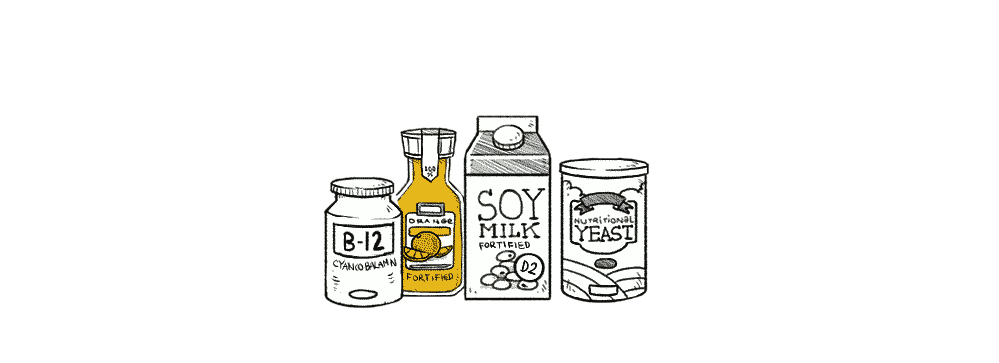
Vitamin B-12 is necessary for the production of DNA and for maintaining nerve cells. Levels need to be over 400 pg/ml — or 4 to 6 mcg per day — for good health. Due to modern agriculture, by nature this vitamin does not occur in any plant.
Sources
- Fortified plant milks
- Fortified foods
- nutritional yeast
- Cyanocobalamin Supplements
Eat two servings a day of fortified foods that contain at least 2-3.5 mcg of vitamin B12, consumed at least 4 h apart for optimal absorption. Another option is to take a daily or weekly supplement of cyanocobalamin B12. A daily dose provides 25-100 mcg of vitamin B12 and a weekly dose is 1,000 mcg, twice per week.
Absorption of vitamin B-12 is tricky. Small amounts of the vitamin attach to receptors that become saturated very fast, and remain this way for hours. This is what you get from a single meal of fortified foods. By ingesting a large dose of B12 from a supplement, your body absorbs the excess that can't latch onto receptors, but that is still a very small amount. Meeting daily goals is easy when ingesting small servings throughout the day. Daily single-dose supplements are bigger since absorption rates are very low.
Read more about vitamin B12. Jump back to top.
Iodine
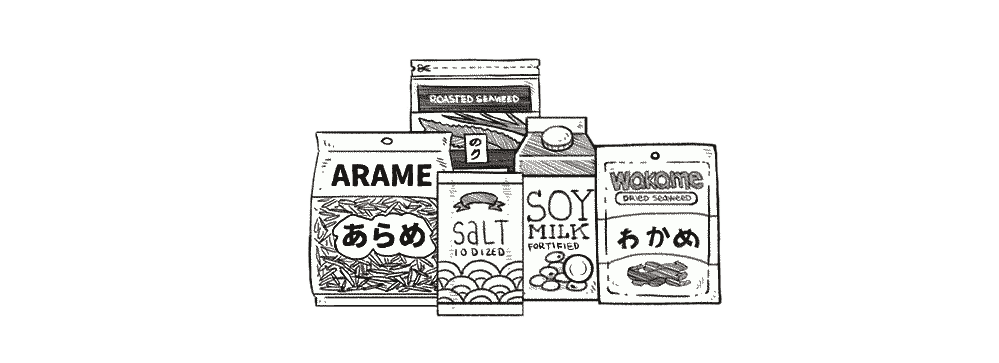
Iodine is necessary for healthy thyroid function which regulates our metabolism.
Sources
- Some fortified plant milks (few are fortified with it)
- Iodized salt, 1/4 tsp/day
- Seaweed
A quantity of 90 micrograms is recommended daily.
The amount of iodine in seaweed and other sea vegetables is variable, it is the same for sea salt and other natural salts. The only reliable sources are iodized salt or supplementation.
Read more about iodine. Jump back to top.
Omega-3's
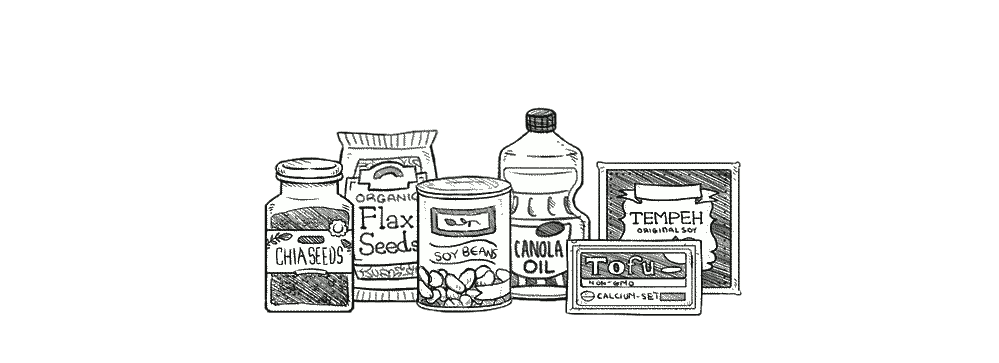
Omega3's are necessary for optimal cognition. This vitamin helps reduce blood clotting (which protects against heart attacks).
Sources
- Chia seeds, 1 tsp | 713mg
- Flax seeds, 1 tsp, ground | 570mg
- soy beans, cooked, 1/2 cup | 500mg
- Tofu, 1 cup | 400mg
- Tempeh, 1 cup | 400mg
- Canola oil, 1 tsp | 433mg
- Flaxseed oil, 1/4 tsp | 608mg
There are 3 omega-3 fatty acids:
- Alpha linolenic (ALA), found in soy, walnuts, canola oil, flaxseeds, hemp seeds oil etc. The body cannot produce its own.
- Eicosapentaneoic acid (EPA), found in small amounts in seaweed.
- Docosahexaneoic acid (DHA), found in small amounts in seaweed. The body can convert EPA into DHA.
Adult males need 1,600 mg/day while females need 1,100 mg/day of ALA.. The numbers vary for babies, infants and pregnant women. To be safe, take 200-300 mg of DHA per day.
Read more about omega-3's. Jump back to top.
Vitamin A
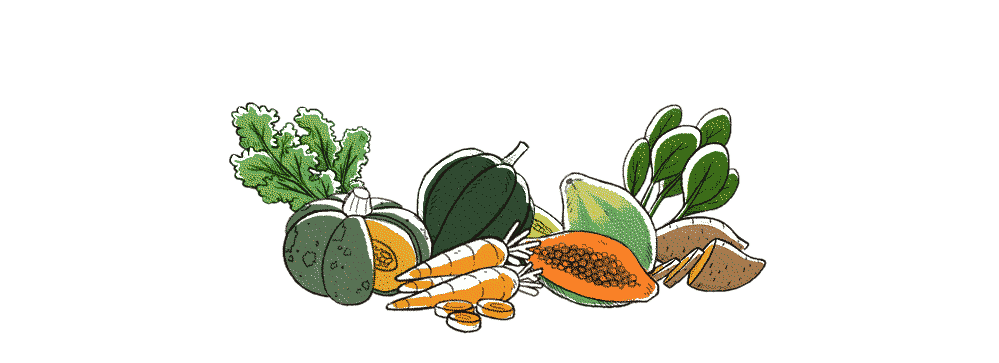
Vitamin A is important for growth and developments in young children, and for red blood cell formation.
Sources
Consume 2 or more per day.
- Butternut squash
- Pumpkin
- Sweet potatoes
- Kale
- Carrots
- Spinach
- Cantaloupe
The body can convert 50 carotenoids into vitamin A, the most common is beta-carotene. Eating vegetables high in carotenoids (carrots, pumpkin etc.) with fat increases the absorption and synthesis of Vitamin A.
Read more about vitamin A. Jump back to top.
Zinc
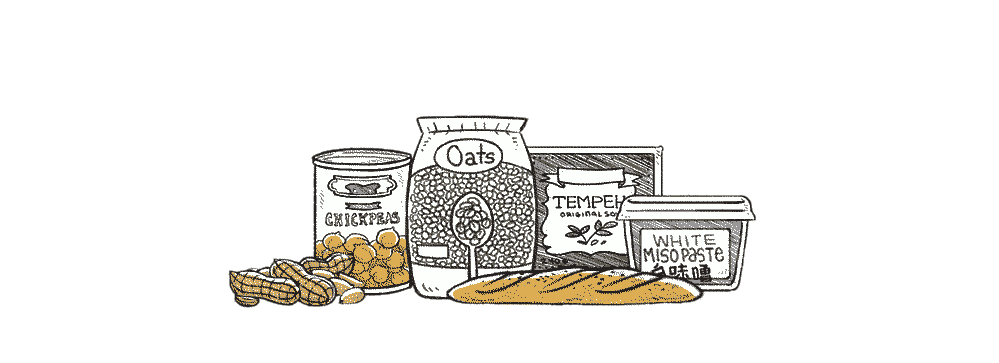
Zinc is important for immunity.
Sources
Adult males (19-50 yrs) need 11mg/day, while adult females (19-50 yrs) need 40 mg/day. These amounts vary for newborns, infants, teens, pregnant/breastfeeding women and older adults.
Phytates, found in some plant foods, reduce zinc absorption. This is why it's important to increase our intake of zinc by at least 50%. Consuming protein — like legumes, leavened bread, fermented soy foods (miso or tempeh) and nuts – increases zinc absorption.
Read more about zinc. Jump back to top.
Meal plans
Jump back to top.
Nutrition references
- Processing and Preparation Practices to Enhance the Bioavailability of Micronutrients in Plant-Based Diets
- Fortification basics
- The vegan RD
- Vegan Health
- Nutrition Facts
- Open Food Facts
See a mistake? Make a pull request on Github. Or contact us on Mastodon. Information last updated on 2024.02.09.
Jump back to top.
